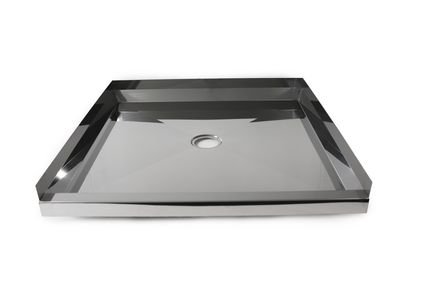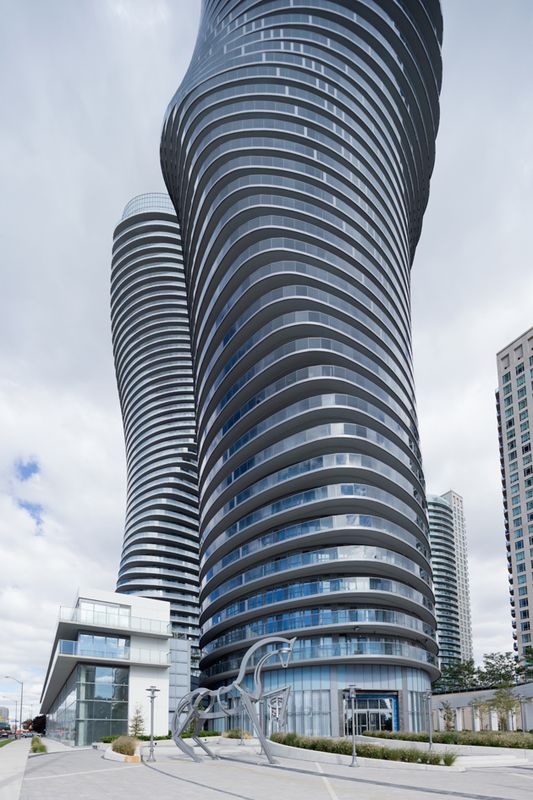Peter Salhani: You’ve both been to many national conferences over the years, what will be some of the important differences between Material and previous conferences?

Material directors: Sandra Kaji-O’Grady and John de Manincor.
Image: Adam Russell
John de Manincor: Let’s start with what will be similar: as in previous years, we think Material will be a fantastic experience (no pun intended). We’re very excited about the lineup of speakers and events! We’ve selected a diverse group of speakers and worked with them to home in on a specific topic [material] that we believe is of great relevance to all practitioners. The format will be similar to other years in that there will be only keynote speakers. We’ve eliminated the usual post-presentation chats which often end just as they get going - instead there will be a focused “round-table” discussion on the Saturday afternoon chaired by Nader Tehrani. Nader’s office NADAAA is collaborating with John Wardle Architects on the new Faculty of Architecture, Building and Planning at the University of Melbourne. The format will be a little like ABC TV’s Q&A – delegates will be able to forward questions to the stage via Twitter and other media.
Sandra Kaji-O’Grady: It’s possibly a more “Catholic” selection of speakers than in previous years, since we have targeted people who can speak to the Material topic from different angles, rather than a group whose formal approach or position are aligned with our own. We’ve been careful not to push a specific architectural ideology. That said, we did set out to improve the representation of women at National Conferences to better reflect the balance of women in the industry. More than 40 percent of the speakers at Material will be women, the highest representation in many years … perhaps ever. They are women who do excellent work in their field.
Templestowe Reserve Sporting Pavilion by PHOOEY Architects. Emma Young of PHOOEY is a speaker at Material.
Image: Peter Bennetts
Render of University of Melbourne’s new faculty of Architecture, Building and Planning by John Wardle Architects and NADAAA.
Hedge Gallery stand by Rael San Fratello Architects for San Francisco Art and Design Show. Director Virginia San Fratello is a speaker at Material.

Sol Grotto installation by Rael San Fratello Architects. Virginia San Fratello is a speaker at Material.
Launch party venue: the RMIT Design Hub by Sean Godsell Architects.
Image: Earl Carter
PS: With the speakers list locked in, there’s a bit of buzz (and perhaps from an event perspective, some trepidation) about them not being “starchitects.” Was it a conscious decision to eschew celebrity status in favour of a specific content focus, or have you simply selected people whose work you admire and are interested in?
JdeM: No doubt household names, “starchitects” if you will, draw a crowd, but their work is readily accessible through a variety of media. We’ve sought out architects and academics who have something vital to say about the multi-faceted topic of “material.” So, yes, very much a focus on content.
SK-O: My experience of past conferences is that the audience get most enthused about people whose work they don’t know, the ones that surprise with totally fresh material. It’s always a joy to come away from the National Conference having been exposed to new people and new ideas. Only about half of the speakers were people whose work we were very familiar with; we spent a lot of time searching to uncover emergent talent. The ambition is to bring people out at the most interesting part of their careers, when they are still energetically hands on, and not the exhausted talking head for an office they rarely have time to visit.
PS: How important to the conference do you think the fringe events are?
JdeM: Extremely important! The Brisbane conference in 2012 set some very high expectations. It would be fair to say if you were to do enough research you might find out a lot about a particular speaker. But the fringe events make it a broader experience overall. Having attended so many of the Institute’s national conferences, I’ve found the interaction with other architects over a drink or a coffee adds a whole other dimension for me … it elevates the conference from a CPD points harvesting show-and-tell to something personal.
PS: So, what’s your pick of the 2013 fringe events?
JdeM: There are so many … the opening party at the new RMIT Design Hub featured in the March/April 2013 edition of Architecture Australia will be huge fun, and a great opportunity for interstate delegates to experience the new building by Sean Godsell. Also, I have an interest in cinema and architecture that stems from my student days, so I’m really excited about the Cinecity event at Federation Square – it has attracted some high quality judges including Bernard Tschumi – I wrote my graduation thesis on him … errr, a while back.
SK-O: For me, personally, it’ll probably be the closing party when we can finally relax! I’m also involved with the Australian Research Council-funded project researching women’s career progression in architecture; the Institute is one of the project’s partners. We are staging a symposium called Transform on the Thursday (28 May) of the conference opening. The symposium, which will be at the University of Melbourne, is to debate gender, agency and remaking the profession. Transform has a great line-up headlined by the New York-based architect and activist Lori Brown. It’s going to be a really important and interesting fringe event discussing issues that many are passionate about.
PS: What are you hoping people will take from the conference, the speakers and the events – and how are you hoping they’ll participate?
SK-O: We were keen that speakers would have the opportunity to get more interaction with Australian architects and architecture students … than just their hour on the stage [to make the long journey here worthwhile]. We approached people in the universities early on in the process to link them up with speakers and that has produced a couple of additional engagements – Matthias Kohler is doing a robotics workshop at RMIT, and Billie Faircloth will visit Monash and UTS. Two exhibitions at the Tin Sheds Gallery at the University of Sydney feature work by conference speakers – Jorge Otero-Pailos leading up to the conference and Selgas Cano immediately after it. It’s so important that the next generation of architects view the conference as the premier event of the Institute, and we believe that these professional gatherings are a great way to introduce students to the Institute’s activities as well as for them to learn from leading practitioners.
JdeM: The overall format will be a show and tell – visually compelling and totally entertaining. Beyond that I hope that the work presented will prompt questions and open opportunities for discussion between delegates in their practice, in print and even online. There’ll be drinks at the end of the conference at the Boatbuilders Yard, next to the conference venue. That will give everyone a better opportunity to mull over and share what’s been shown and talked about, and to meet the speakers.
PS: To document your conference manifesto, you were invited to guest-edit the May/June edition of Architecture Australia which comes out before the conference kicks off. What can readers expect to see in this issue?
JdeM: Architecture Media has been the official media partner of the National Conference for a long time. This is the first time that AA will provide, not so much a preview of speakers, or even a conference review, but an issue that expands on the “manifesto.” We’ve worked with Cameron Bruhn (editorial director) to select current Australian projects that somehow pick up on some of the ideas of the conference theme. For example the ambitious Stawell Steps in rural Victoria – a design-build project by students and staff of Monash University, as well as works by Cox Rayner, Paul Morgan, Collins and Turner, Lacoste Stevenson and installations by a number of Sydney architects for the I Love Todd Sampson theatre pro bono collaboration.
SK-O: We hope the additional insight into the topic prior to the conference will get delegates thinking before speakers begin their address. The Dossier section includes illustrated essays on material authenticity, biomaterials, material innovation and an interview with Dave Pigram and Iain Maxwell of Supermanoeuvre and James Gardiner who is heading Laing O’Rourke’s Engineering Excellence Group.
The National Architecture Conference is presented by the Australian Institute of Architects. The 2013 Material program of events and speakers is available online.
Early Bird conference registration sales close on Monday 22 April; go to the Material website.
Architecture Media is the media supporter of the National Architecture Conference.

























